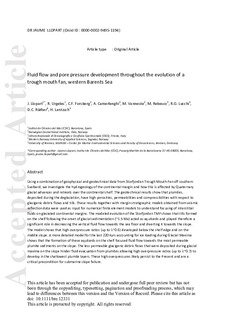| dc.contributor.author | Llopart, J. | |
| dc.contributor.author | Urgeles, R. | |
| dc.contributor.author | Forsberg, Carl Fredrik | |
| dc.contributor.author | Camerlenghi, A. | |
| dc.contributor.author | Vanneste, Maarten | |
| dc.contributor.author | Rebesco, M. | |
| dc.contributor.author | Lucchi, Renata Giulia | |
| dc.contributor.author | Rüther, Denise Christina | |
| dc.contributor.author | Lantzsch, H. | |
| dc.date.accessioned | 2019-01-07T08:26:03Z | |
| dc.date.available | 2019-01-07T08:26:03Z | |
| dc.date.created | 2018-12-18T09:19:10Z | |
| dc.date.issued | 2018 | |
| dc.identifier.issn | 0950-091X | |
| dc.identifier.uri | http://hdl.handle.net/11250/2579371 | |
| dc.description.abstract | Using a combination of geophysical and geotechnical data from Storfjorden Trough Mouth Fan off southern Svalbard, we investigate the hydrogeology of the continental margin and how this is affected by Quaternary glacial advances and retreats over the continental shelf. The geotechnical results show that plumites, deposited during the deglaciation, have high porosities, permeabilities and compressibilities with respect to glacigenic debris flows and tills. These results together with margin stratigraphic models obtained from seismic reflection data were used as input for numerical finite element models to understand focusing of interstitial fluids on glaciated continental margins. The modeled evolution of the Storfjorden TMF shows that tills formed on the shelf following the onset of glacial sedimentation (~1.5 Ma) acted as aquitards and played therefore a significant role in decreasing the vertical fluid flow towards the sea floor and diverting it towards the slope. The model shows that high overpressure ratios (up to λ~0.6) developed below the shelf edge and on the middle slope. A more detailed model for the last 220 kyrs accounting for ice loading during Glacial Maxima shows that the formation of these aquitards on the shelf focused fluid flow towards the most permeable plumite sediments on the slope. The less permeable glacigenic debris flows that were deposited during glacial maxima on the slope hinder fluid evacuation from plumites allowing high overpressure ratios (up to λ~0.7) to develop in the shallowest plumite layers. These high overpressures likely persist to the Present and are a critical precondition for submarine slope failure. | |
| dc.language.iso | eng | |
| dc.title | Fluid flow and pore pressure development throughout the evolution of a trough mouth fan, western Barents Sea | |
| dc.type | Peer reviewed | |
| dc.type | Journal article | |
| dc.description.version | acceptedVersion | |
| dc.source.journal | Basin Research | |
| dc.identifier.doi | Basin Research, 31(3), 487-513 doi:10.1111/bre.12331 | |
| dc.identifier.cristin | 1644620 | |
| cristin.unitcode | 7452,4,3,0 | |
| cristin.unitname | Offshore geoteknikk | |
| cristin.ispublished | false | |
| cristin.fulltext | postprint | |
| cristin.qualitycode | 2 | |
